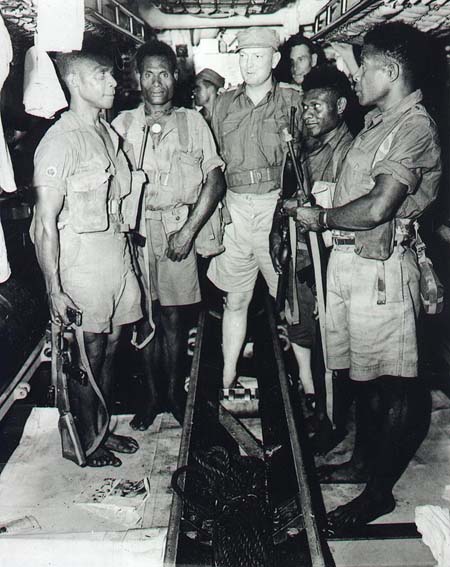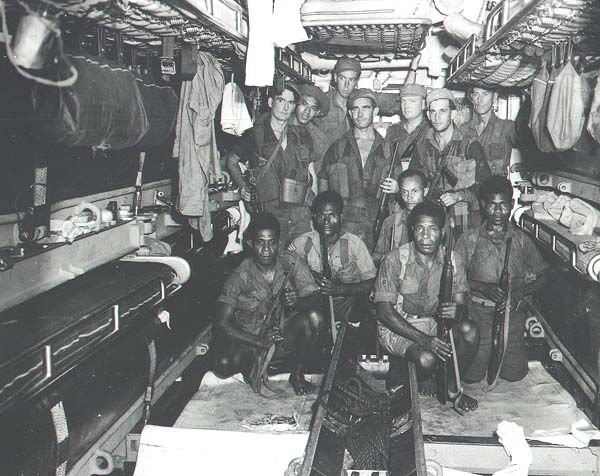 Lieutenant G. C. Harris of the Royal Australian Navy and his
band of guerillas aboard the USS Dace (SS-247) in March, 1944.
Lieutenant G. C. Harris of the Royal Australian Navy and his
band of guerillas aboard the USS Dace (SS-247) in March, 1944.
 Harris and his men were under the direction of the Allied Intelligence
Bureau (AIB), being sent to scout enemy-held positions on islands throughout
the South Pacific. They were veterans of many incursions into the tropical
jungles where they would observe troop movements, aircraft departures and
arrivals, then radio their observations back to AIB. Lieutenant R.B. Webber
(RAN), was second in command. Five more Caucasians and five New Guinea
natives brought the group's number to twelve. A sergeant from Indonesia
acted as an interpreter, and the rest were former policemen, sent along
to control any unfriendly natives encountered along the way.
For two days a Navy photographer, brought on board for the special
mission, took many pictures of the beaches and terrain around Biak. Sketches
were drawn up, and at eight o'clock, Dace surfaced and closed in on the
island, while Harris and his party prepared to disembark.
The Skipper did not like the looks of the area, and with great
concern that the small bay was mined, decided to take the Dace up the coast
a little farther. Just as the group was about to get into their rubber
boats, the Japs lit up the beach with truck headlights and searchlights,
apparently in search of something. Captain Claggett said, "Hell, we can't
go in there!" A quick decision was made to go around to the other side
of the island.
Three hours later, just after midnight, Lieutenant Harris and
part of his group prepared to leave the boat. Everything was going according
to plan as they paddled the two thousand yards to shore, until the rubber
raft carrying the communications equipment was overturned by several large
waves. Lieutenant Harris was flung onto a small outcrop of coral reef and
broke his leg.
There are differing opinions as to what transpired next. One
report stated that upon their discovery by natives, Harris signaled the
Dace to tell the remaining members of the group to stay aboard and also
send a boat back for him and his party. The signals were somehow misinterpreted
and the remaining eight commandos went ashore in their rubber boats two
hours later.
Once the group was assembled, they tried to move inland. A few
natives were encountered and through his interpreter, Harris told them
what he wanted to do. "Friendly" natives offered to guide the party, but
a short while into their journey they disappeared into the jungle, leaving
the small band of men, who were then attacked from three sides by the Japs.
Four of the commandos were killed, and Harris was wounded. He
told the others to "Leave me and go ahead!" Several of the men fled into
the jungle and escaped. The plucky Australian, lying on the ground with
three bullets in him, was propped up against a tree by the Japs, where
he was grilled for information. "Where did you come from? How did you get
here? What is your mission? Where is the next Allied invasion going to
take place?"
The bleeding commando leader refused to divulge any information,
and was brutally stabbed with Japanese bayonets several times before he
died. The remaining members of the group hightailed it inland where they
hid out in the jungles until Allies landed on the island.
Later on, Captain Bladen D. Claggett said, "There was no mixup.
The signal was received to land the remaining members of the party, so
we did."
(Photos Courtesy of John Mansfield, Jr., RM2(SS), Menhaden,
1963-65; and, the above information is from John Mansfield, Jr.'s book,
"Cruisers
for Breakfast." Copyright, October, 1997)
Harris and his men were under the direction of the Allied Intelligence
Bureau (AIB), being sent to scout enemy-held positions on islands throughout
the South Pacific. They were veterans of many incursions into the tropical
jungles where they would observe troop movements, aircraft departures and
arrivals, then radio their observations back to AIB. Lieutenant R.B. Webber
(RAN), was second in command. Five more Caucasians and five New Guinea
natives brought the group's number to twelve. A sergeant from Indonesia
acted as an interpreter, and the rest were former policemen, sent along
to control any unfriendly natives encountered along the way.
For two days a Navy photographer, brought on board for the special
mission, took many pictures of the beaches and terrain around Biak. Sketches
were drawn up, and at eight o'clock, Dace surfaced and closed in on the
island, while Harris and his party prepared to disembark.
The Skipper did not like the looks of the area, and with great
concern that the small bay was mined, decided to take the Dace up the coast
a little farther. Just as the group was about to get into their rubber
boats, the Japs lit up the beach with truck headlights and searchlights,
apparently in search of something. Captain Claggett said, "Hell, we can't
go in there!" A quick decision was made to go around to the other side
of the island.
Three hours later, just after midnight, Lieutenant Harris and
part of his group prepared to leave the boat. Everything was going according
to plan as they paddled the two thousand yards to shore, until the rubber
raft carrying the communications equipment was overturned by several large
waves. Lieutenant Harris was flung onto a small outcrop of coral reef and
broke his leg.
There are differing opinions as to what transpired next. One
report stated that upon their discovery by natives, Harris signaled the
Dace to tell the remaining members of the group to stay aboard and also
send a boat back for him and his party. The signals were somehow misinterpreted
and the remaining eight commandos went ashore in their rubber boats two
hours later.
Once the group was assembled, they tried to move inland. A few
natives were encountered and through his interpreter, Harris told them
what he wanted to do. "Friendly" natives offered to guide the party, but
a short while into their journey they disappeared into the jungle, leaving
the small band of men, who were then attacked from three sides by the Japs.
Four of the commandos were killed, and Harris was wounded. He
told the others to "Leave me and go ahead!" Several of the men fled into
the jungle and escaped. The plucky Australian, lying on the ground with
three bullets in him, was propped up against a tree by the Japs, where
he was grilled for information. "Where did you come from? How did you get
here? What is your mission? Where is the next Allied invasion going to
take place?"
The bleeding commando leader refused to divulge any information,
and was brutally stabbed with Japanese bayonets several times before he
died. The remaining members of the group hightailed it inland where they
hid out in the jungles until Allies landed on the island.
Later on, Captain Bladen D. Claggett said, "There was no mixup.
The signal was received to land the remaining members of the party, so
we did."
(Photos Courtesy of John Mansfield, Jr., RM2(SS), Menhaden,
1963-65; and, the above information is from John Mansfield, Jr.'s book,
"Cruisers
for Breakfast." Copyright, October, 1997)



